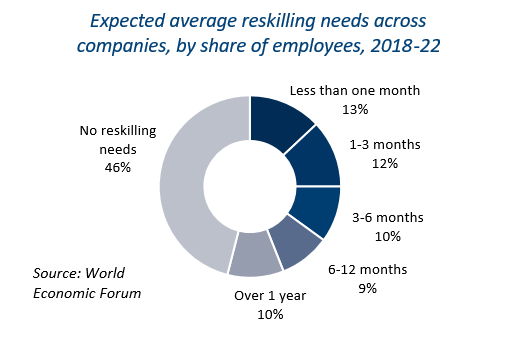Economists and futurists no longer ask what the future of work will look like, but rather when it will come and how disruptive it will be. Automation, artificial intelligence and other technological advancements are in the workplace today. Some say that innovations should be embraced and, like technological advancements in the past, the average American, and the economy as a whole, will be better off. Others issue dire warnings that automation and robotics will render many occupations obsolete and displace millions of American workers.
So which is it? The rose or the thorns?
 The answer is, it’s complicated. According to the World Economic Forum, automation is expected to displace 75 million workers around the world by 2022. That’s a staggering sum — and in just four years. But the same report predicts that 133 million jobs will be created during the same period. What is almost certain is that, in the next few years, the world economy — and by extension, the American workforce — will experience a significant transformation as businesses adopt new technologies and American workers adapt and reskill to fill new jobs.
The answer is, it’s complicated. According to the World Economic Forum, automation is expected to displace 75 million workers around the world by 2022. That’s a staggering sum — and in just four years. But the same report predicts that 133 million jobs will be created during the same period. What is almost certain is that, in the next few years, the world economy — and by extension, the American workforce — will experience a significant transformation as businesses adopt new technologies and American workers adapt and reskill to fill new jobs.
A new study out of the Boston University School of Law illuminates potential impacts of automation by examining survey data for non-financial private firms in the Netherlands. The researchers obtained data on automation expenditures for more than 36,000 firms over a 16 year period, from 2000 to 2016, in order to measure the effects of automation on employment and wages.
The researchers estimate that wages decreased for incumbent workers by about 8.2 percent over five years as a result of automation. However, recent hires experienced no wage loss and even earned 4.4 percent higher income over five years. It follows that the impact of automation will be more severe for older, more experienced workers, who at best will experience shifts in their day to day tasks and at worst will need to pursue further education, training and credentials to adapt.
For policymakers and economists, this begs the question: can anything be done to prepare for automation and new technology in the workplace?
The Brookings Institute recommends five actions to prepare for the future of work:
- Embrace growth and technology, which will encourage firms to step up hiring and training new workers as the economy heats up;
- Promote a constant learning mindset by expanding traditional education, reducing the financial burden for skill attainment, and fostering employer-sponsored learning opportunities;
- Facilitate a smoother adjustment by investing in career counseling, retraining opportunities and unemployment support for displaced workers;
- Reduce hardships for workers who are struggling through the expansion of state and federal safety net programs;
- Mitigate harsh local impacts by expanding support to vulnerable regions and communities that may be hardest hit.
Automation and artificial intelligence in the workplace will augment human skill and improve productivity. New technologies like autonomous vehicles and voice recognition will make it easier for all individuals — particularly individuals with disabilities — to access work and participate in civil society. But the future of work will likely bring with it disruption and displacement, and this burden will be disproportionately borne by workers in particular industries, occupations and geographic regions. Federal, state and local policymakers should consider clear strategies to prepare for the future of work. The time to act is now.
Research Roundup
Meanwhile, here is the latest roundup of research and data related to Career Technical Education (CTE):
- There’s a racial gap in CTE enrollment. The National Center for Education Statistics reports that, according to high school transcript data, white students earned more (3.2) CTE credits on average than black (2.9), Hispanic (2.6), Asian (2.2) and mixed race (2.9) students.
- The American Association of Community Colleges developed an infographic based on a recent Pew Research Center study that depicts the different post-high school plans of today’s teens. One notable takeaway: 12 percent of teens plan to attend a two-year college and 4 percent plan to attend a technical or vocational school after high school.
- Skills training is pretty popular with American voters. According to polling from ALG Research, with support from the National Skills Coalition, 93 percent of likely 2020 voters support increasing investments in skills and technical training.
- It’s not just you — CTE is getting more popular. The American Enterprise Institute looked at media mentions of CTE between 2012 and 2018 and found that the number of articles mentioning CTE has increased by more than a hundredfold in that time.
Austin Estes, Senior Policy Associate
